Scicomm Article
The scicomm article that I have attached above, aims to educate my audience on a misconception about wolves that has been around for a significant amount of time. By analyzing a research study from David Mech and using persuasive writing techniques I correctly depicted the meaning of the word "alpha wolf" and how no such thing exists. I created my article by using wolves as the protagonist and formed it into a story to explain the significance of an "alpha pair" to a wolf pack and how they act as parents to the other wolves. By organizing it as an introduction with interesting facts followed by a thorough analysis of the research, I hoped that readers would be able to build a connection with wolves.
This project has taught me a lot about how to analyze and summarize research in an effective way to educate my audience on a particular topic. The most important thing I learned was how to simplify scientific research in a way that anyone can understand. Another thing I learned was methods on how to foster engagement with my audience. Methods such as persuasive and descriptive language helped me keep the audience interested in the topic. Overall, writing the scicomm article has been a wonderful experience that has taught me many skills about conveying research studies that I hope to apply to the future.
Advocacy Project
How to Resolve Human-Wolf Conflicts
By: Vinay Raja
Introduction
The population of wolves continues to RAPIDLY decrease. And it is our fault. Since the early 1900s, when wolf persecution started to show serious signs against ecosystems, conflicts between humans and wolves have only got worse.
The progression of human activities into the territory of wolves causes wolves to become aggressive and humans fight back in return. This never-ending cycle must come to an end and return to a time when humans and wolves can live in peace with one another.
Recent research shows the underwhelming causes of these conflicts and offers solutions to resolve them. "Since 1987 total confirmed minimum livestock losses in NW Montana totaled 82 cattle, 68 sheep, 7 dogs, and 2 llamas. Depredations averaged 6 cattle, 5 sheep, and less than 1 dog annually", states Edward E. Bangs, the U.S. Fish and Wildlife's Grey Wolf Recovery Coordinator. Farmers and ranchers that exist near wolf territory are one of the leading causes of human-wolf conflicts.
As shown by the data, humans have become intruders in wolf territory and their livestock has become free dinner for the wolves in the region, ultimately upsetting the farmers. Conservation methods must be put in place NOW for the sake of wolves as well as farmers.
It is also important to learn about the importance that wolves have to the environment. They are vital carnivores that exist at the top of the food chain and play a key role in regulating the ecosystem. By eating smaller animals, they ensure that the ecosystem is stable and organized.
So let us ask ourselves: Why are we having such tense conflicts with such important and fascinating creatures?

This image shows a beautiful wolf pack ready for their next meal!
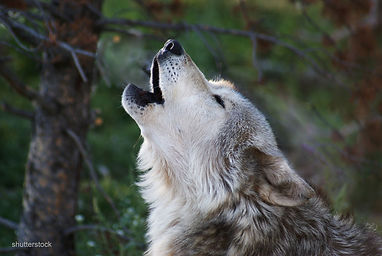
Issues with Livestock

Here is an image that portrays affected farm areas by wolves and the different densities.
Wolves living near cattle and other forms of livestock pose to be the biggest cause of human-wolf conflicts. Every day there are farmers all around the U.S. waking up to much of their cattle dead due to nearby wolves.
The Environmental Impact Statement from 1994 stated that "100 adult-sized wolves would kill about 10-20 cattle and 50-70 sheep in each recovery area, worth $2,000 to $30,000, annually." If we put ourselves in the shoes of a farmer, we can only imagine how frustrating it would be to lose so much profit due to the presence of wolves.
Wolves preying on livestock leads to farmers retaliating and some states, such as Idaho, have even mandated hunters to kill off wolves to protect the livestock.
"Wolf-Human Interactions in Alaska and Canada: A Review of the Case History", published by researcher Mark McNay in 2002 states, "Government-sponsored wolf control was implemented to reduce wolf predation on big-game prey species." Governments have been encouraging wolf control all through the 1900s which is not the right way to resolve this issue. Wolves are posing a financial burden to farmers and in return, they are being killed. They are being called "evil" creatures by many, but in reality, they are hungry and need to eat just like humans.
Wolves are already on a path to extinction and their conflict with humans does not help this case. Together, we can resolve this issue and help unite the two species once again.
Public Views on Wolves
Public opinions on wolves drastically affect how tense the conflict is between humans and wolves.
"Public perspectives and media reporting of wolf reintroduction in Colorado" published in 2020 by Rebecca Niemiec shows how residents of Colorado felt when they found out wolves would be reintroduced to the region, "we also find that a portion of the public believes that wolves would negatively impact their livelihoods, primarily because of concerns over the safety of people and pets, loss of hunting opportunities, and potential wolf predation on livestock."
Though around 66% of the participants of the survey voted in support of the wolves and their contribution to the ecosystem, the negative side, specifically livestock predation, is what gets the most media coverage. The media makes it seem that wolves are terrible creatures that are having a negative impact on the lives of humans. When in reality, most humans support the reintroduction of them and the benefits the provide.
As shown in the image to the right, a significant amount of residents are in favor of the reintroduction of wolves. The media alters many of these opinions as they focus on the negative aspects. This then leads to a widespread hatred towards wolves which heightens the conflicts between humans and wolves.
We must act fast to spread the correct information on wolves and ensure they are correctly viewed by the public instead of getting misled by the media.
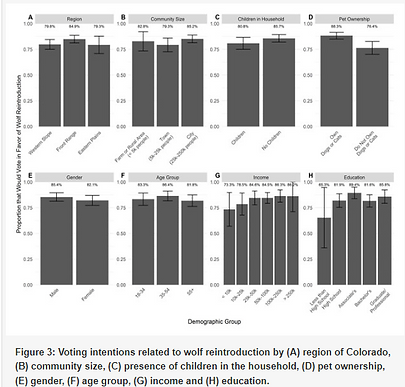
Here are multiple polls by different categories showing support towards the reintroduction of wolves.
25 years of conflict

Red areas show the highest risk for livestock while blue shows the least.

Image of very hungry wolves preying on livestock.
It is important to consider previous data on human-wolf conflicts and how we can use it to predict future trajectories.
Human-wolf conflicts have not always been around. The tension between humans and wolves only started to rise quickly in the late 1800s/early 1900s due to multiple industrial and scientific revolutions. These revolutions caused an increase in human activities which destroyed the environment of wolves, causing a long-lasting conflict.
A study published in 2004 by Adrian Treves, an independent researcher, aims to predict the future of human-wolf conflicts by analyzing data consisting of 25 years.
This data was collected by analyzing forest-agriculture landscapes in Wisconsin and Minnesota. Treves used 17 landscape variables to determine which ones caused the highest chance of human-wolf conflict. Treves states, " Rather, wolves preyed on livestock in townships sharing a consistent set of landscape features across both states, despite dramatic differences in the two states' wolf population sizes, wolf control policies, and farm sizes." Variables that attracted the most wolves included a high rate of pasture/deer, low rates of cropland/forest area, and farm size.
Though this data may not seem very important or interesting, it is actually very crucial to limiting human-wolf conflicts. Treves states, "Locally, wildlife managers, researchers, and farmers could use our spatial models to tailor research and interventions according to local conditions." With this data, we can track trends and prevent farmers from having ranches near these high-risk areas (map on the left).
The overall problem of human-wolf conflicts comes down to humans invading the area of wolves without the proper knowledge. Without understanding the dynamics of wolves and why they tend to hunt livestock in areas with these variables, the conflict will only get worse. We, as humans, need to understand that wolves are hungry just like us and livestock are an easy meal for them. Killing wolves is a terrible solution as they are vital for many ecosystems. Action must happen NOW!
Global Solution
What can be done on an authoritative scale? Local as well as global governments can have a significant impact on the management of wolves.
The study, "Characterizing wolf-human conflicts in Wisconsin, USA", published through the Wildlife Society Bulletin by Erik R. Olsen, a professor at Northland College, advocates for the need to resolve human-wolf conflicts through specific management tactics. Olsen's data that he has collected throughout a span of 12 years pinpoints three different classifications of human-wolf incidents: residential, farmland, and wildlife.
Why does this matter? Well, the research's overwhelming idea is that each interaction between the two species has different scenarios. Olsen highly recommends that each classification should have its own solution and management plan. For example, Olsen states, "For residential-associated incidents, the presence of alternative attractants was more variable than that for farm-associated incidents and included things such as wild game, carcasses of wild game, or apples from an apple tree." As shown, Olsen explains how each geographical area has different reasons for attracting wolves and local governments should take each measure into consideration before making an uneducated decision on what to do with the wolves.
Without the proper knowledge or reasoning for a management decision, the lives of wolves are suddenly put in danger. Local and global governments must consider these specific factors when deciding how to resolve human-wolf conflicts:
"1) what behaviors characterize habituated wolves
2) what characteristics of wolf–human conflict determine whether or not human safety concerns should be considered
3) under what conditions should lethal control be implemented" (Olsen 2015, 1).
This global/local solution is the best and most efficient method to ensure the protection and safety of humans and wolves. Not every interaction is the same and wolf management decisions should be carefully reviewed through the questions that Olsen presents.

Counts of different conflicts and the associated species

Using Lethal Force Against Wolves
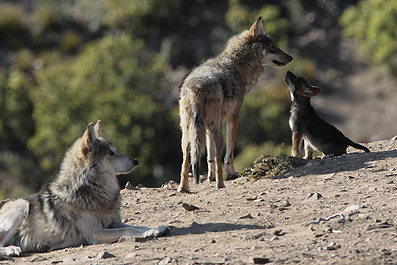
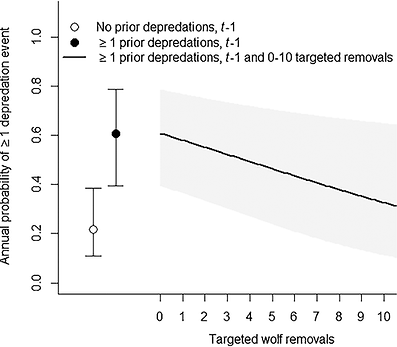
Now you may ask: why can we not just kill more wolves? Hunting and killing wolves will, in fact, decrease livestock depredation and limit human-wolf conflicts around the world. It is a very easy solution that can be applied in areas where wolves are a serious threat to humans and nearby livestock.
For example, in "Wolf-livestock conflict and the effects of wolf management", a research study published by Nicholas Decesare in 2018, concluded that targeted removals, "effectively reduced the subsequent frequency of depredations to 0 as more wolves were removed." The data and results show that targeted removal is very effective in limiting human-wolf conflict to almost none!
However, have you considered how important wolves are to the environment? Wolves play a drastic role in regulating ecosystems and prey populations all around the world. As stated by the California Wolf Center, "Wolves are what’s referred to as a 'keystone species', which is any species that other plants and animals within an ecosystem largely depend on. If a keystone species is removed, the ecosystem would drastically change, and in some cases, collapse." Wolves are vital to the environment and killing them is unjust and also unfair to the other animals that exist in the ecosystem.
For example, after wolves were reintroduced to Yellowstone National Park in the late 1900s, "Elk, moose, and bison carcasses from wolf kills provided plenty of leftovers for other animals to scavenge." Not only do wolves thrive, but their presence allows all other animals to thrive in the region. Without these carnivores being at the top of the food chain, many ecosystems would collapse and cause the death of millions of other animals. Hence the targeted removal of wolves should not be a go-to solution.
Education and Outreach
Governments and organizations take quite some time to process new laws and rules regarding wolves. So what is another way to resolve these constant fights between humans and wolves?
The answer is to simply educate and teach the public about wolves and how important they are to nature. The research study, "Fear of the Wolf: Are Human-Wildlife Conflicts Actually Human-Human Feuds?", published in 2023 by Lisa Marcz highlights the division of opinions on wolves which is one of the main causes of human-wolf conflict. Due to historical events regarding wolf attacks, many people view wolves as "evil" and "very dangerous to the public". Though they can be dangerous, the media tends to overexaggerate this topic. Marcz argues for, "a social guideline to bridge the communication gap between humans who have opposing opinions on coexisting with wolves."
Through education and outreach about the correct information on wolves and how important they are to the environment, humans can welcome the idea of reintroducing wolves as well as limit hunting laws on them. Humans being on the same page will drastically decrease the amount of conflicts between humans and wolves and allow us to return to a time of peace.


What more can we do?

Image from Wolf Conservation Center Twitter
One of the main ways to influence public opinion is through the use of social media and how many campaigns advocate for solutions to problems such as human-wolf conflicts.
For example, the #StandForWolves campaign on Twitter helps advocate for humans and wolves to coexist with one another. Their campaign has assisted the process of many laws and new policies to help conservation methods for wolves.
Throughout this quarter, I have learned the power of social media and how important it can be to advocate for a cause. Though I was indifferent to the idea at first, I quickly realized how sharing useful and accurate information and garner the attention of many people across the world.
So together, we can have a significant impact on resolving human-wolf conflicts. By sharing information and credible research studies, anyone can help save these fascinating creatures and educate others about their outstanding contribution to the environment. Let us come together, and learn how to coexist with wolves once again.
Infographic and Gallery of Wolves
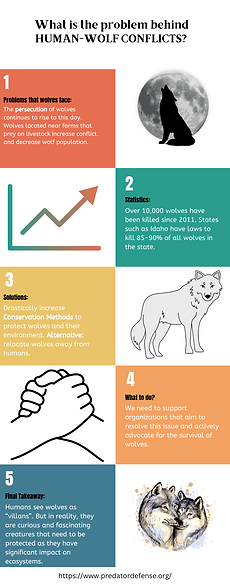





Works Cited
Bangs, Edward E., et al. “Managing wolf–human conflict in the Northwestern United States.” People and Wildlife, July 2001, pp. 340–356, https://doi.org/10.1017/cbo9780511614774.022.
DeCesare, Nicholas. J., et al. “Wolf‐livestock conflict and the effects of wolf management.” The Journal of Wildlife Management, vol. 82, no. 4, 1 Feb. 2018, pp. 711–722, https://doi.org/10.1002/jwmg.21419.
“The Importance of Wolves.” California Wolf Center, 2023, www.californiawolfcenter.org/biodiversity#:~:text=Wolves%20are%20what’s%20referred%20to,and%20in%20some%20cases%2C%20collapse.
McNay, Mark E. “Wolf-Human Interactions in Alaska and Canada: A Review of the Case History.” Wildlife Society Bulletin, vol. 30, no. 3, 2002, pp. 831–843. Autumn, https://doi.org/https://www.jstor.org/stable/3784237?seq=1.
Märcz, Lisa, and Michael Gibbert. “Fear of the wolf: Are human-wildlife conflicts actually human-human feuds?” Society & Animals, 14 Sept. 2023, pp. 1–20, https://doi.org/10.1163/15685306-bja10142.
Niemiec, Rebecca, et al. “Public perspectives and media reporting of wolf reintroduction in Colorado.” PeerJ, vol. 8, 7 May 2020, https://doi.org/10.7717/peerj.9074.
Olson, Erik R., et al. “Characterizing wolf-human conflicts in Wisconsin, USA.” Wildlife Society Bulletin, vol. 39, no. 4, 26 Nov. 2015, pp. 676–688, https://doi.org/10.1002/wsb.606.
TREVES, ADRIAN, et al. “Predicting human‐carnivore conflict: A spatial model derived from 25 years of data on wolf predation on livestock.” Conservation Biology, vol. 18, no. 1, 30 Jan. 2004, pp. 114–125, https://doi.org/10.1111/j.1523-1739.2004.00189.x.



